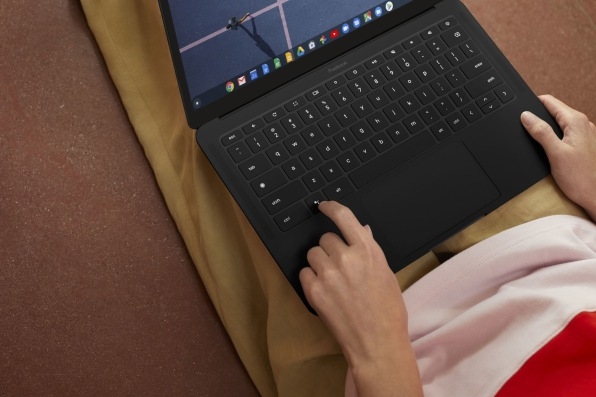Pixelbook Go: a happy medium between budget and high-end Chromebooks
Beginning in 2013 with the original Chromebook Pixel—the first touch-screen Chrome OS device—and continuing through 2017’s Pixelbook, the Chrome OS laptops that Google has designed and sold itself have been expensive, high-end devices. In contrast, the company’s new Pixelbook Go had two primary design goals: creating a more mobile and affordable Pixelbook experience. It starts at $649–not cheap by overall standards for Chromebooks, but considerably less intimidating than past Pixelbook prices. And it’s largely successful at what it apsires to do.
In its “Just Black” color, with a 13? display and only a “G” for branding on its corner, the two-pound Pixelbook Go evokes the “Chromium-48” laptop that started the Chromebook journey way back in 2010, when Google seeded the device to developers and reviewers as a sort of platform preview. That’s fitting, as the Go is a back-to-basics machine for Google after its foray into 2-in-1 tablet/laptop devices with last year’s Pixel Slate. It fills a marketplace gap for those drawn to Chrome OS who have wanted something with better design and materials than the slew of cheap Chromebooks but who have balked at the pricey Pixelbook.

In contrast to the sharp angles of the first two Pixelbooks, the Go has a softer, curvier design. A modern laptop, its only connectors are USB-C ports on each side and a headphone jack. Google put a charging status LED next to both connectors, a thoughtful touch. In my experience, the Pixelbook Go charged fine with a few third-party USB-C power adapters, but not with Apple’s USB-C charger for MacBooks.
Unlike many Windows laptops with touch screens, the Pixelbook Go doesn’t have a 360-degree hinge that lets you rotate the screen around into a tablet-like mode. Other cost-saving moves have largely affected the display. Google has replaced the Pixelbook line’s signature 3:2 screen aspect ratio with a wider, more common 16:9 display that is not as well suited to long web pages. It also doesn’t support the stylus introduced last year with the Pixelbook Slate. The PixelBook Go’s pixel density is relatively low by contemporary standards at 166 pixels per inch, but text was crisp and the screen brightness held up well to sunlight coming in over my shoulder on an overcast day.
Google characterizes the device’s signature design element–a wavy surface on the case’s bottom reminiscent of the cooking surface of a George Foreman grill–as enhancing its mobility, making the device easier to grasp. I found that it didn’t do much to compensate for the smooth texture of the device’s magnesium frame, but it might make a bigger difference with the kind of silicone shells that many people put on their MacBooks.
Touch and Go
Chrome OS’s support for touch screens has taken on more importance since Chrome OS began supporting Android apps. Such apps were a key part of the Pixel Slate tablet; they play a lesser role on a Chrome OS laptop like the Pixelbook Go. Still, they’re a welcome option, since many Android apps, such as the pen pal app Slowly and Google’s own podcast app, lack web counterparts. Android also provides access to a huge library of inexpensive games, albeit of varying quality. And Chromebooks get to tap into Google Play Pass, the monthly subscription service that provides ad-free access to many apps that you’d otherwise need to purchase on a one-off basis.

Overall, though, the Go provides a great experience. It’s responsive and offers excellent battery life, getting me through two half-day sessions of use that included substantial video viewing without the need to recharge. Its keyboard offers a satisfying springiness while being noticeably quieter than those on other platforms, and its touchpad offers no surprises. It delivers lively audio from the speaker grilles located astride the keyboard.
At a starting price of $649 with Intel’s Core m3 processor (extending up to $849 for the tested Core i5 version and $1,399 for a Core i7 version), the Pixelbook Go starts out at hundreds of dollars less than the high-end Pixelbook and $150 less than a Pixel Slate without a keyboard. Prior to the announcement of the Go, Google took the unusual step of announcing that it would not be producing any more tablets. However, the company still positions the Pixel Slate as part of a three-device portfolio that includes the Go and Pixelbook. Among that lineup, the Go will certainly become the most popular option based on the value it offers for the price.
Basic Chromebooks are among the most affordable computing devices, with major PC brands offering models for less than $300 with both smaller (11.6?) and larger (15.6?) displays. The Go stands out from these category-dominating entry-level devices with better performance (some Chromebooks are based on cheap ARM processors), better battery life, better materials, a better keyboard, and better audio. It marries thoughtful if low-frills mobile PC design with the smooth functioning of Chrome OS, a once-radical operating system that is better accommodated by apps and services with each passing year.
Fast Company , Read Full Story
(16)

